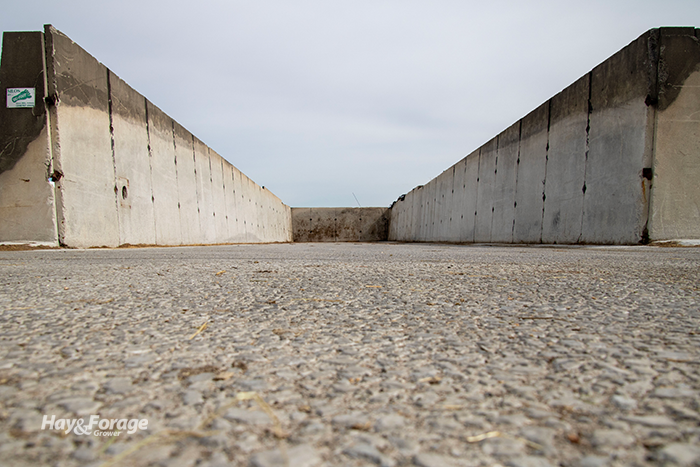
The next few weeks will be a busy time for farmers and forage choppers who are harvesting corn for silage and taking final cuttings of alfalfa. Targeting moisture and maturity levels for these feed crops is the first hurdle of fall harvest. The second hurdle is putting forage in storage as quickly and efficiently as possible.
Acid production is a cornerstone for haylage and silage fermentation. Lactic acid in particular is critical to lower forage pH and preserve its quality before storage losses occur. These acids, however, can negatively affect the integrity of a storage structure, especially if it is founded on concrete.
In a recent Farm Report issue from the Miner Agricultural Research Institute in Chazy, N.Y., Ev Thomas explains the difference between concrete and asphalt durability. According to the retired agronomist, it’s all about chemistry.
Concrete floors under bunker silos and drive-over piles are lime based and subject to degradation by fermentation acids. Thomas notes these structures will begin to break down as soon as the first load of forage is delivered to them.
On the other hand, asphalt is petroleum based, so it is more resistant to acidic breakdown. These floors and pads can last several years longer than concrete ones. In fact, Thomas says the concrete bases in bunker silos at the Miner Institute became badly pitted with pieces of aggregate coming loose in less than a decade. The asphalt bases in two newer bunker silos at the research farm, however, are still in adequate condition after more than 30 years.
Unlike the floors under bunker silos, drive-over pile pads aren’t always protected with a lip or ramp around the perimeter. Therefore, the edges of these pads are subject to crumbling over time, no matter the surface material.
Asphalt is no more equipped to withstand the weight and pressure of forage trucks and packing tractors than concrete, and Thomas says the edges of any drive-over pad can eventually look like the cracked shoulders of a high-traffic road.
Seal coatings
Maintenance for asphalt floors and pads is typically overlooked. Thomas notes many farmers do not apply a seal coating to asphalt bases regularly, if at all; however, farm managers at the Miner Institute decided to do so in the 32-year-old bunker silos earlier this spring.
The seal coating was intended to close cracks in the asphalt floor that was allowing water to seep up from below the base and spoil the bottom layer of feed. Rachel Dutil with the Miner Institute explains that the process is the same as sealing a driveway and can be completed by the same professionals.
When a bunker silo is empty, sweep it out and blow it clean to eliminate stray feed particles and fines. After cracks are filled, allow at least 24 hours for the sealing to set. The two-day process requires a dry weather forecast.
Although the employees at the research farm resolved to reseal asphalt bases every three to five years, Thomas surmises seal coatings may be more relevant to older asphalt that is more susceptible to cracking. A thick layer of gravel under the bunker silo floor and drainage pipes around the perimeter of the structure should prevent — or at least minimize — spoilage from water in most other situations. With that said, keep an eye on asphalt and be prepared to update bases as horizontal silo floors age.

